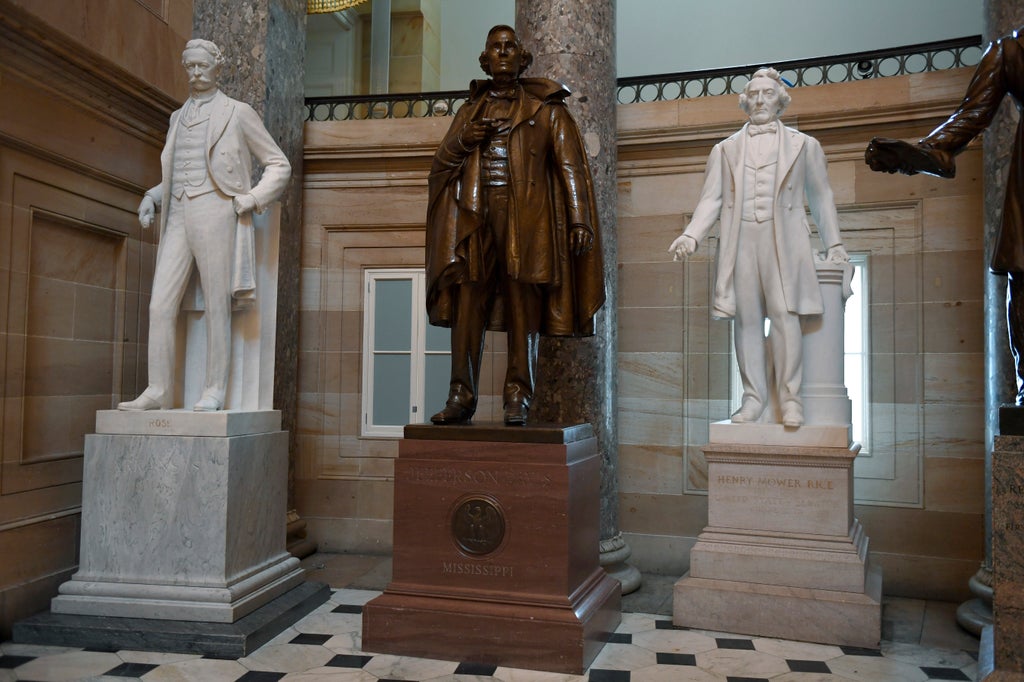The House of Representatives has voted to move statues of Confederate figures from the US Capitol, reviving an attempt to remove racist symbols from places of prominence that stalled in Congress last year.
But more Republicans voted against the measure this time than they did last year under a similar proposal.
Only 67 Republicans joined Democrats to pass the bill, which would direct the Capitol architect to remove a dozen statues from public view. The measure passed by a vote of 285 to 120.
The proposal also would replace a bust of former US Supreme Court Justice Robert Taney – who issued the high court’s decision that defended the enslavement of African Americans – with a bust of Thurgood Marshall, the court’s first Black justice.
During debate on 29 June, several House Republicans – including House Majority Leader Kevin McCarthy, who launched a tirade against critical race theory in the middle of his remarks – falsely connected the current Democratic Party to the ideologies and political platforms of the party in the 1800s, selectively omitting the parties’ realignment in the early 20th century around integration and a civil rights movement that prompted their opponents to flee for the Republican Party.
House Majority Whip James Clyburn of South Carolina reminded GOP lawmakers that prominent segregationist Strom Thurmond left the Republican Party “and took all those segregationists with him.”
That party “built itself on the Confederate battle flag,” he said on the House floor on Tuesday. (Mr Thurmond’s 1948 presidential campaign ran on the short-lived Dixiecrat platform, which waved the Confederate flag.)
US Rep Karen Bass said the Democratic Party is “extremely aware” of its history of racism.
“It is my hope that my colleagues on the other side of the aisle will go back to that history of the Republican Party that you honor, and fight for the right for all Americans to vote,” she said.
During last year’s vote and on Tuesday, the only members of Congress who voted to keep the monuments were Republicans. Only 72 voted to remove them, while 113 voted to keep them in place.
In the wake of racial justice uprisings, demonstrators and state and local officials across the US have sought to take down and replace monuments to the Confederacy that dot the nation’s cities and state houses.
In 2017, New Orleans officials removed four Jim Crow-era statues to Confederate leaders and white supremacists erected in the aftermath of Reconstruction and violent segregation. That year, a deadly white supremacist riot in Charlottesville, Virginia, sought to block the removal of a monument to Confederate general Robert E Lee.
That year, at least 36 monuments to Confederate figures were removed across the US.
Last year, that figure was nearly 100.
Congressman Clyburn’s legislation directs the Capitol architect to remove statues of “indiuals who voluntarily served the Confederate States of America” – including its president, Jefferson Davis, and vice president, Alexander Stephens, whose statues are prominently installed in the Capitol’s Statuary Hall.
Each state is invited to submit two statues to the hall’s collection, though Congress does not have authority to remove them. Several states have voluntarily replaced some of them – Virginia intends to replace its statue of General Lee with civil rights leader Barbara Johns, and North Carolina will submit a statue of Rev Billy Graham to replace one of Charles Brantley Ayock, a white supremacist who defended the disenfranchisement of Black voters and helped stage a racist insurrection to overthrow a recently elected biracial government.
House Majority Leader Steny Hoyer said it is “time to remove those symbols of slavery, segregation, and sedition from these halls”.
US Rep Zoe Lofgren, chair of the House Administration Committee, said it it “long past time” to remove monuments to people “who favored war against the United States in support of a so-called government founded on a cornerstone of racism and white supremacy.”
The legislation also specifically names statues of three men, including Aycock, John Calhoun and James Paul Clarke.
“John C Calhoun is not here because he defended the southern states,” said Mr Clyburn, referring to the former vice president who defended slavery as a “necessary evil”.
“John C Calhoun died in 1850, more than a decade before the Civil War started,” Mr Clyburn said. “Why did South Carolina send this statue here for us to honor?”
In his 1857 ruling in the landmark Dred Scott v Sandford case, Justice Taney wrote that people of African descent – whether they were free or born into enslavement – were not considered American citizens, and argued that they “had for more than a century before been regarded as beings of an inferior order and altogether unfit to associate with the white race, either in social or political relations”.
He held that they “had no rights which the white man was bound to respect; and that the Negro might justly and lawfully be reduced to slavery for his benefit”.
The ruling was later voided by ratification of the US Constitution’s 13th Amendment, which abolished slavery except as punishment for a crime, and the 14th Amendment, which guarantees citizenship for people born in the US or under its jurisdiction.
The measure now heads to the US Senate, where the 2020 legislation languished under Republican control. It could face similar opposition in the evenly died upper chamber of Congress.




